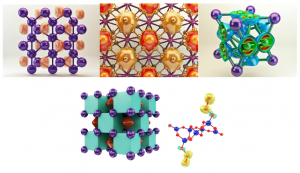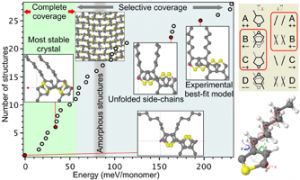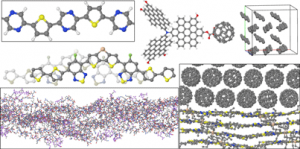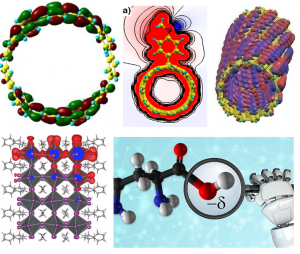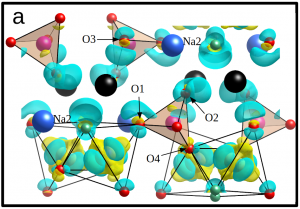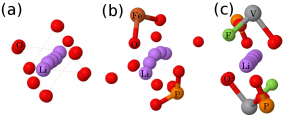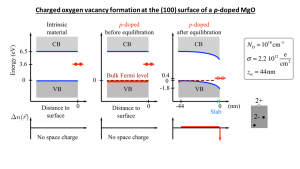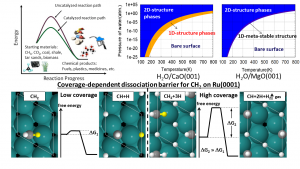Science highlights
Interactions, spectroscopy and dynamics of trapped atoms and ions Laboratory (PI: Professor Alexei Buchachenko https://faculty.skoltech.ru/people/alexeibuchachenko )
The group focuses on the accurate ab initio calculations of interatomic interactions that determine spectral and collisions-induced properties of the ultracold atomic ensembles, ions in the traps, systems isolated in inert matrices, steady-state ion transport in the media, etc. Precision matters.
- Ultracold atomic spectroscopy and dynamics (PRA2017a https://journals.aps.org/pra/abstract/10.1103/PhysRevA.95.063421, PRA2017b https://journals.aps.org/pra/abstract/10.1103/PhysRevA.96.063405, PRL2018 https://journals.aps.org/prl/abstract/10.1103/PhysRevLett.121.173402)
- Stability of the trapping sites and spectroscopy of atoms and dimers in inert matrices (sponsored by Russian Science Foundation; JPCA2017 https://pubs.acs.org/doi/10.1021/acs.jpca.6b12444, LTP2018 https://aip.scitation.org/action/showLargeCover?issue=42336489)
- Gas-phase ion transport (sponsored by Russian Basic Research Fund, JCP2018 https://aip.scitation.org/doi/10.1063/1.5025861, JCP2019 https://aip.scitation.org/doi/10.1063/1.5071457?ai=1gvoi&mi=3ricys&af=R
[PRA2017a] M. Morita, J. Klos, A. A. Buchachenko, and T. V. Tscherbul, Cold collisions of heavy 2Σ molecules with alkali-metal atoms in a magnetic field: Ab initio analysis and prospects for sympathetic cooling of SrOH(2Σ) by Li(2S), Phys. Rev. A, 2017, 95, 063421. [PRA2017b] M. Borkowski, A. A. Buchachenko, R. Ciurylo, P. S. Julienne, H. Yamada, Y. Kikuchi, K. Takahashi, Y. Takasu, and Y. Takahashi, Beyond-Born-Oppenheimer effects in sub-kHz precision photoassociation spectroscopy of ytterbium atoms, Phys. Rev. A, 2017, 96, 063405. [PRL2018] T. Sikorsky, M. Morita, Z. Meir, A. A. Buchachenko, R. Ben-shlomi, N. Akerman, E. Narevicius, T. V. Tscherbul, and R. Ozeri, Phase locking between different partial waves in atom-ion spin-exchange collisions, Phys. Rev. Lett., 2018, 121, 173402. [JPCA2017] N. N. Kleshchina, K. A. Korchagina, D. S. Bezrukov, and A. A. Buchachenko, Modeling of manganese atom and dimer isolated in solid rare gases: Structure, stability, and effect on spin coupling, J. Phys. Chem. A, 2017, 121, No.12, pp.2429-2441. [LTP2018] G. K. Ozerov, D. S. Bezrukov, and A. A. Buchachenko, Computational study of the stable atomic trapping sites in Ar lattice, Low Temp. Phys., 2019, 45, No.3, pp.301-310). [JCP2018] A. A. Buchachenko and L. A. Viehland, Interaction potentials and transport properties of Ba, Ba+, and Ba2+ in rare gases from He to Xe, J. Chem. Phys., 2018, 148, 154304. [JCP2019] D. S. Bezrukov, N. N. Kleshchina, I. S. Kalinina, and A. A. Buchachenko, Ab initio interaction potentials of the Ba, Ba+ complexes with Ar, Kr and Xe in the lowest excited states, J. Chem. Phys., 2019, 150, 064314.
Computational Materials Discovery Lab (PI: Professor Artem R. Oganov)
Our laboratory develops global optimization methods for the prediction of atomic structure of crystals and low-dimensional materials (surfaces, polymers, nanoclusters, etc.) and for predicting materials with desired properties. We also develop techniques for predicting mechanisms of phase transitions. Our methods are implemented in our code USPEX (http://uspex-team.org), used by numerous researchers and companies around the world. Some highlights include:
- Discovery of a new unique superhard material WB5 (JPCL 2018).
- Discovery of transparent form of sodium (Nature 2009a), discovery of the crystal structure of superhard gamma-boron (Nature 2009b).
- Discovery of new unexpected sodium chlorides (e.g. Na3Cl, NaCl3, etc. – Science 2013) stable under pressure.
- Discovery of helium chemistry under pressure – which started with our predicted compounds Na2He and Na2HeO (Nature Chemistry 2017).
- Prediction of novel high-temperature superconductors (JPCL 2018, Sci. Adv. 2018).
- Elucidation of the structure of surfaces of alpha-boron (PRL 2013), rutile TiO2 (PRL 2014), silica polymorphs (Sci. Rep. 2018).
Multiscale Modeling Group (PI: Assistant Professor Alexander Shapeev)
The main research theme of the Multiscale Modeling Group is an application of machine learning to molecular modeling. The projects that we currently work on are:
- Machine-learning interatomic potentials. These are models of interaction of atoms that are alterna tive to quantum-mechanical models (too slow) and empirical potentials (too inaccurate). We collaborate with materials scientists and chemists on: materials discovery, modelling cathodes, first-principles calculation of alloy phase diagrams, prediction of chemical reaction rates.
- Application of machine learning to elastic strain engineering is another ideologically similar project we do.

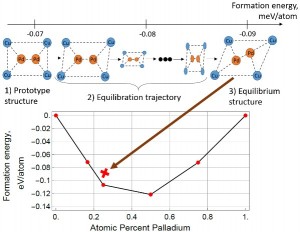
Organic semiconductors (PIs Profs. Andriy Zhugayevych and Sergei Tretiak)
We perform multiscale modeling of organic semiconductors for applications in optoelectronics, sensing, energy conversion and storage. Experiment is conducted in the group of Prof. Pavel Troshin. Highlights include:
- State of the art modeling of solar cells (ARPC 2015), light emitters (ChemSci 2015), field effect transistors and photodetectors (AFM 2018), emerging biomaterials (AM 2015)
- Structure prediction for semicrystalline polymers (JPCC 2018)
- Development of fragmentation approaches for extended systems (ChemSci 2017)
Theoretical chemistry and spectroscopy lab (PI: Adj. Prof. Sergei Tretiak)
We are developing modern computational methods to model optical and electronic properties, and dynamics of electronically excited states in molecular, nanoscale and semiconducting materials. Some highlights include:
- Coherent non-adiabatic molecular dynamics of excitons in conjugated organic chromophores (Nature Comm., 9, 2316, 2018);
- Optical response of semiconducting carbon nanotubes (Nature Chem., 10, 1089, 2018);
- Electronic properties mixed halide perovskites (Nature Comm., 9, 2525, 2018; Science, 360, 67, 2018);
- Machine learning and data science complementing conventional quantum chemistry (J. Phys. Chem. Lett., 9, 4495, 2018).
Dmitrii Aksenov
- Understanding intercalation sequence in lithium and sodium iron fluorophosphates with DFT calculations (J. Am. Chem. Soc., 2018)
-
Understanding cation migration barriers in oxide and phosphate based cathode materials with DFT calculations
-
Development of computational framework SIMAN for high-throughput DFT calculations
-
Solubility and grain boundary segregation of alloying elements in metals (Comput. Mat. Sci, 2012, 2015, 2017)
-
Radiation swelling in vanadium radiation-resistant alloys (J. Nucl. Mater. 2017 )
Unifying Concepts in Catalysis Lab (PI: Assistant Professor Sergey V. Levchenko)
Our research focuses on first-principles modeling of complex materials (surfaces, interfaces, nano-structured systems) and phenomena (defect formation and interaction, statistical effects, dynamics, kinetics) at realistic temperature, pressure, and doping conditions in general, and heterogeneous catalysts and catalytic processes in particular. Here are some highlights:
- Influence of ferroelectric polarization on the equilibrium stoichiometry of ferroelectric surfaces at realistic temeratures and oxygen partial pressures (Physical review letters 100, 256101 (2008))
- Concentration of vacancies at semiconductor surfaces including charge-carrier-doping effects (Physical review letters 111, 045502 (2013))
- Stability and metastability of clusters in a reactive atmosphere: Theoretical evidence for unexpected stoichiometries (Physical review letters 111, 135501 (2013))
- Controlling molecular dissociation on a catalyst surrface through surface site blocking by co-adsorbates (Journal of catalysis 320, 89 (2014))
- Developing artificial intelligence approaches to finding descriptors for rational materials design (Physical review letters 114, 105503 (2015))
- Hybrid functionals for large periodic systems in an all-electron, numeric atom-centered basis framework (Computer Physics Communications 192, 60 (2015))
- First-principles supercell calculations of small polarons with proper account for long-range polarization effects (New Journal of Physics 20, 033023 (2018))
More highlights to be added…
